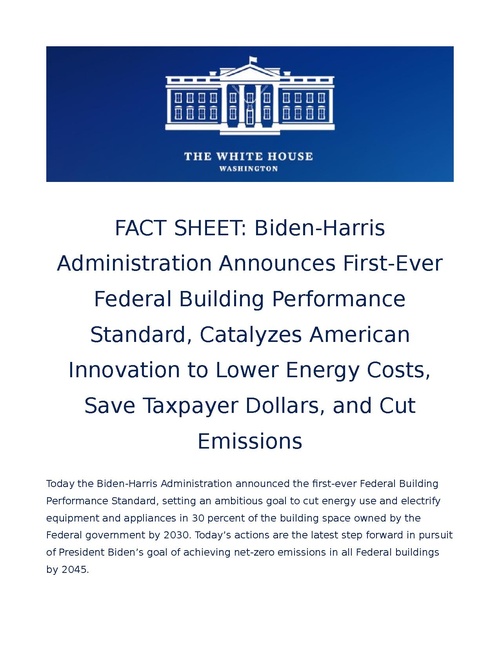White House Launches Coalition to Strengthen Building Performance Standards
| News | |
| Image | 
|
|---|---|
| Published | 2022-12-07 |
| Point(s) of Contact | |
| Organization(s) | White House |
| Where | Washington DC |
| Display | Yes |

| |
The Biden-Harris Administration announced the first-ever Federal Building Performance Standard, setting an ambitious goal to cut energy use and electrify equipment and appliances in 30 percent of the building space owned by the Federal government by 2030.
Today’s actions are the latest step forward in pursuit of President Biden’s goal of achieving net-zero emissions in all Federal buildings by 2045.
As a complementary step, today the U.S. Department of Energy (DOE) announced a proposed rulemaking to electrify new Federal buildings and Federal buildings undergoing major renovations. As the country’s single largest energy consumer and building manager, these new actions will save taxpayer dollars by reducing energy use while cutting millions of tons of greenhouse gas emissions, increasing resilience, strengthening U.S. energy independence, and growing the jobs of the future in America.
Additionally, the State of California announced it is joining the President’s National Building Performance Standard Coalition, a nationwide group of over 30 state and local governments that have committed to reducing the emissions footprint of existing buildings. With the addition of California to the coalition and the new Federal Building Performance Standard, one quarter of all commercial, Federal, and multifamily buildings in the United States are now either covered by or moving toward sustainable building performance standard policies.
In the United States, residential and commercial buildings represent 35 percent of carbon dioxide emissions. Commercial and government buildings cost $190 billion to power each year. With eighty percent of all existing U.S. buildings expected to remain in service in 2050, electrifying existing buildings is essential to achieving President Biden’s climate goals.
Council on Environmental Quality Announces First-Ever Building Performance Standard for Existing Federal Buildings
The Council on Environmental Quality’s (CEQ) Federal Building Performance Standard requires agencies to cut energy use and electrify equipment and appliances to achieve zero scope 1 emissions in 30 percent of their buildings by square footage by 2030. To reach that mark, agencies will be buying American-made products such as heat pumps, electric water heaters, and other energy efficiency and building system technologies supported by the Inflation Reduction Act.
Federal buildings are a major source of the U.S. Government’s direct greenhouse gas (GHG) emissions. Energy used in Federal buildings for space heating, water heating, cooking, and other needs account for over 25 percent of Federal emissions. In addition to lowering costs, efficient electrification of building equipment and appliances reduces air pollution—improving health in workplaces and communities.
Upgrading the Federal building portfolio to meet the new standard will reduce reliance on imported fossil fuels from volatile parts of the world and cut millions of tons of GHG emissions. Funding provided through the President’s Bipartisan Infrastructure Law, agency operating budgets, and the Climate Smart Buildings Initiative will aid implementation. To further reduce costs and maximize efficiencies, agencies will apply electrification strategies in conjunction with deep energy retrofits, energy use and water use reductions, and other facility improvements.
Department of Energy Releases Clean Energy Rule for New Federal Buildings
Today DOE released a Supplemental Notice of Proposed Rulemaking seeking public comment on a forthcoming rule, Clean Energy for New Federal Buildings and Major Renovations of Federal Buildings, to support building decarbonization. The rule would set emissions reduction targets and require equipment and appliance electrification in new Federal buildings as well as Federal buildings undertaking major renovations. The rule is projected to save $8 million per year in building costs. The Federal Building Performance Standard and the rule work together to ensure a comprehensive approach to Federal building decarbonization while reinforcing the urgency to reduce GHG emissions and creating new markets and well-paying jobs.
President Biden’s Building Performance Standard Coalition Grows
The State of California today announced that it has joined the National Building Performance Standard Coalition, a White House initiative to accelerate building performance standards across over 30 state and local governments. California joins Colorado, Washington, and cities including New York City, Washington, D.C., St. Louis, Boston, and many others in committing to developing building performance standards with a goal of adoption by Earth Day 2024. As a result of building performance standards applied across jurisdictions participating in the National BPS Coalition, it is estimated that $124 billion will flow into the building electrification and construction industry by 2040.
To support building owners, developers, and contractors seeking to meet a building performance standard, the President’s Inflation Reduction Act provides substantial tax incentives. Under the revised Energy-Efficient Commercial Buildings Deduction, 179D, the total available deduction for developers and contractors completing these projects will nearly triple, increasing from $1.80 per square foot to potentially $5.00 per square foot, depending on the project’s demonstrated increase in energy efficiency. Further, the Inflation Reduction Act expanded eligibility for the deduction to a broader range of organizations, including non-profits and Tribal governments. The Department of Treasury (Treasury) recently announced that it will release notices to collect input from stakeholders, experts, and the public on key climate and energy tax provisions of the law.
To support effective city and state building performance policies, DOE and the Environmental Protection Agency (EPA) are providing guidance and technical assistance for policymakers and program administrators. Policy design and implementation support includes analysis, policy design, implementation, and stakeholder engagement. DOE and EPA are further collaborating to facilitate access to new Federal programs and related activities that reduce emissions from the built environment.
Agencies Are Taking Action Now to Cut Building Energy Use and Emissions
In response to the President’s early executive orders and Federal sustainability goals, Federal agencies are advancing net-zero goals across new building construction, major modernizations, and existing building retrofits—electrifying systems, saving energy, and lowering emissions. Highlights include:
Last month the General Services Administration (GSA) announced that it will not use Inflation Reduction Act funding to install fossil fuel-based equipment, a commitment that reaffirms the Federal Government’s commitment to building electrification. In 2023, GSA will open the Des Moines U.S. Courthouse, a new all-electric, energy-efficient Federal courthouse for the Southern District of Iowa that features a highly reflective cool roof, insulated windows, and LED lighting. Next year GSA also will complete the modernization of the Denver Federal Center Building 48, an existing vacant warehouse that will be converted into an efficient, all-electric 150,000-square foot office space for the Department of the Interior. Modernizing this existing building will minimize embodied carbon emissions, and it will be designed and operated to achieve net zero carbon emissions.
Earlier this year DOE announced a $38 million Net Zero Labs (NZL) Pilot Initiative to decarbonize four national laboratories and lay the foundation to address hard-to-decarbonize industries. The Initiative will demonstrate solutions that can be replicated at facilities across DOE, state and local governments, and the Federal Government. Project examples from this initiative that will meet the new Federal Building Performance Standard include: By 2023, DOE’s National Renewable Energy Laboratory (NREL) will eliminate the use of gas at its Flatirons Campus by converting four existing facilities to electric heating. Further, NREL aims to eliminate the use of gas for heating and switch to a carbon-free district heating and cooling system at its South Table Campus by 2027.
In 2021, DOE’s Pacific Northwest National Laboratory (PNNL) began a replacement project to upgrade a gas-fired boiler and steam system at Battelle Inhalation Lab with two efficient electric boilers. Additionally, in 2023, PNNL will replace aging gas-fired steam systems that support four buildings with new high efficiency electric systems. These conversions will improve facility reliability and increase energy efficiency, yielding significant cost savings and reducing GHG emissions. Across the commercial building sector, more than 40 companies—representing 1.2 billion square feet—have joined DOE’s Better Climate Challenge where they’ve committed to reducing portfolio-wide GHG emissions by at least 50 percent by 2030. These owners are accelerating decarbonization efforts throughout all of their buildings, and sharing common sense solutions for cutting energy waste across the country.